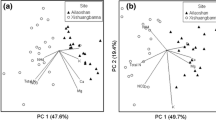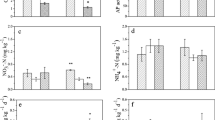Abstract
Litter decomposition was studied at two forested watersheds in east Tennessee which differed primarily in their past history of atmospheric S input. Cross Creek Watershed, located near a large coal-fired power plant, has received greater S inputs than the more remote Camp Branch Watershed. Decomposition was estimated through the measurement of forest floor respiration, litter microflora populations, litter and soil microarthropod populations, and litter nutrient status. Average forest floor respiration rates were very similar, 6.78 g CO2 m−2 day−1 or 2472 g m−2 yr−1 at Camp Branch and 6.86 g CO2 m−2 day−1 or 2505 g M−2 yr−1 at Cross Creek. Fractional loss rates provided estimates of annual decay rates (k) of 0.35 and 0.39 for Camp Branch and Cross Creek, respectively. Litter decomposition was estimated to contribute 23% of the total CO2 output at Camp Branch and 26% at Cross Creek, while root respiration accounts for about 43 to 46%. Bacterial and fungal populations were about equal in size at both watersheds, with bacteria averaging 100 × 106 g−1 of litter and fungi 23 × 106 g−1 of litter. Total numbers of arthropods averaged 34% greater at Camp Branch. Acarina populations averaged 59% higher at Camp Branch, while Collembola numbers were about equal at the two watersheds. Nutrient mobility in the litter and soil was similar at both watersheds. The order of decreasing mobility was K, Mg, Ca, S, N, and P. Litterfall nutrient concentrations were slightly higher for all elements at Cross Creek, resulting in greater litter concentrations of Ca and Mg. Litter concentrations of S and N, however, were significantly greater at Camp Branch, indicating watershed differences in the loss rates and cycling processes of these elements. There were no differences between the loss rates or litter concentrations of P, K, and Na at either site. Overall, decomposition was similar at the two watersheds. Historic S inputs do not appear to have had a major effect on decomposition rate or decomposer organisms with the possible exception of lowered arthropod populations at Cross Creek.
Similar content being viewed by others
References
Abrahamsen, G., Horntvedt, R., and Tveite, B.: 1977, Water, Air, and Soil Pollut. 7, 57.
Anderson, J. M.: 1973, J. Appl. Ecol. 10, 361.
ADAC: 1971, Official Methods of Analysis of the AOAC (12th ed.), Washington, DC.
Attiwill, P. M.: 1968, Ecology 49, 142.
Baath, E., Berg, B., Lohm, U., Lundgren, H., Rosswall, T., Soderstrom, B., and Wein, A.: 1980, Pedobiologia 20, 85.
Bocock, K. L.: 1964, J. Ecol. 52, 273.
Bocock, K. L. and Gilbert, O.: 1957, Plant and Soil 9, 1985.
Bocock, K. L., Gilbert, O., Capstick, C. K., Twinn, D. C., Waide, J. S., and Woodman, M. J.: 1960, J. Soil Sci. 11, 1.
Cromack, K.: 1973, ‘Litter Production and Decomposition in a Mixed Hardwood Watershed and a White Pine Watershed at Coweeta Hydrologic Station, North Carolina’, Ph.D. Dissertation, Univ. of Georgia, Athens, GA.
Edwards, C. A., Reichle, D. E., and Crossley, D. A.: 1969, Ecology 50, 495.
Edwards, N. T.: 1975, Soil Sci. Soc. Am. J. 30, 361.
Edwards, N. T. and Harris, W. F.: 1977, Ecology 58, 431.
Edwards, N. T. and Sollins, P.: 1973, Ecology 54, 406.
Edwards, N. T.: 1982, Pedobiologia 23, 321.
Edwards, N. T. and Ross-Todd, B. M.: 1983, Soil Sci. Soc. Am. J. 47, 1014.
Feher, D.: 1933, Untersuchungen uber die Mikrobiologie des Waldbodens, Springer-Verlag, Berlin.
Gist, C. S. and Crossley, D. A.: 1975, Am. Midl. Natur. 93, 107.
Gosz, J. R., Likens, G. E., and Bormann, F. H.: 1973, Ecol. Mono. 43, 173.
Holm, E. and Jensen, V.: 1972, Oikos 23, 248.
Hovland, J.: 1981, Soil Biol. Biochem. 13, 23.
Jenny, H., Gessel, S. P., and Bingham, F. T.; 1949, Soil Sci. 68, 419.
Joossee, E. N. G. and van Vliet, L. H. H.: 1984, Pedobiologia 26, 249.
Kahn, H. L.: 1971, Analytical Methods for Atomic Absorption Spectrophotometry, Perkin-Elmer Co., Norwalk, CN, 132 p.
Kelly, J. M.: 1979, EPA-600/7-79-053, 158 p.
Kelly, J. M.: 1984a,in E. L. Stone (ed.), Forest Soils and Treatment Impacts, University of Tennessee-knoxville, 265 p.
Kelly, J. M.: 1984b, J. Environ. Qual. 13, 405.
Kelly, J. M.: 1984c, Water, Air, and Soil Pollut. 22, 143.
Kelly, J. M. and Henderson, G. S.: 1978, Soil Sci. Soc. Am. J. 42, 972.
Kelly, J. M. and Meagher, J. F.: 1986, in D. L. Corell(ed.), Watershed Research Perspectives, Smithsonian Press, Washington, DC, 451 p.
Kelly, J. M. and Strickland, R. C.: 1984, Water, Air, and Soil Pollut. 23, 431.
Likens, G. E., Bormann, F. H., Pierce, R. S., Eaton, J. S., and Johnson, N. M.: 1977, Biogeochemistry of a Forested Ecosystem. Springer-Verlag, New York.
Lousier, J. D. and Parkinson, D.: 1978, Can. J. Bot. 56, 2795.
MacLean, D. A. and Wein, R. W.: 1978, Can. J. Bot. 56, 2730.
Martin, J. P.: 1950, Soil Sci. 69, 215.
McBrayer, J. F. and Reichle, D. E.: 1971, Oikos 22, 381.
Olson, J. S.: 1963, Ecology 44, 322.
Ramseur, G. S. and Kelly, J. M.: 1981, J. Tenn. Acad. Sci. 56, 99.
Reiners, W. A. and Reiners, N. M.: 1970, J. Ecol. 58, 497.
Rodin, L. E. and Bazilevitch, N. I.: 1967, Production and Mineral Cycling in Terrestrial Vegetation, Scripta Technica Ltd., London.
Ruhling, A. and Tyler, G.: 1973, Oikos 24, 402.
SAS Institute: 1985, SAS User's Guide, SAS Institute, Inc., Raleigh, NC.
Shanks, R. E., and Olson, J. S.: 1961, Science 134, 194.
Steel, R. G. D. and Torrie, J. H.: 1960, Principles and procedures of Statistics, McGraw-Hill, New York.
Tatum, C. O., Wiklander, G., and Popovic, B.: 1977, Water, Air, and Soil Pollut. 8, 75.
Thomas, W. A.: 1970, J. Appl. Ecol. 7, 237.
Tullgren, A.: 1918, Z. Angew. Ent. 4, 149.
Williams, S. T., McNeilly, T., and Wellington, E. M. H.: 1977, Soil Biol. and Biochem. 9, 271.
Witkamp, M.: 1963, Ecology 44, 370.
Witkamp, M.: 1966a, Ecology 47, 194.
Witkamp, M.: 1966b, Ecology 47, 492.
Witkamp, M.: 1974, Soil Sci. 118, 155.
Witkamp, M. and Van der Drift, J.: 1961, Plant and Soil 15, 295.
Author information
Authors and Affiliations
Additional information
Author for all correspondence.
Rights and permissions
About this article
Cite this article
Larkin, P., Kelly, J.M. Influence of elevated ecosystems levels on litter decomposition and mineralization. Water Air Soil Pollut 34, 415–428 (1987). https://doi.org/10.1007/BF00282742
Received:
Revised:
Issue Date:
DOI: https://doi.org/10.1007/BF00282742




